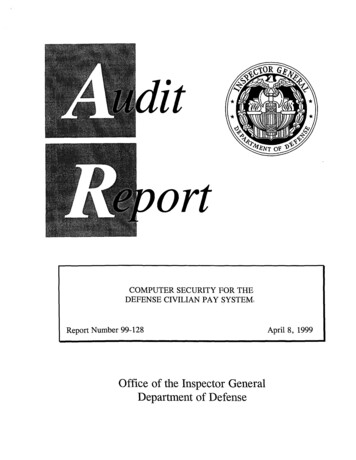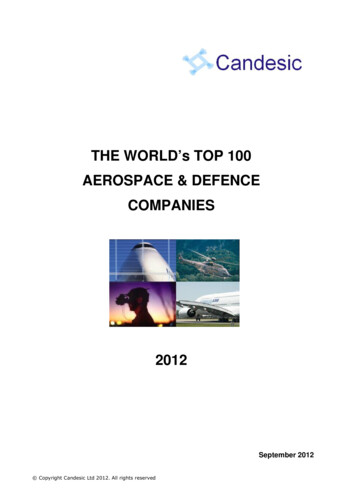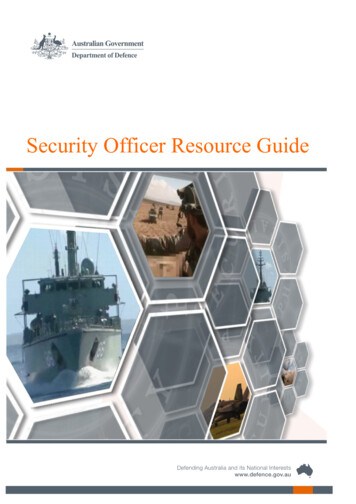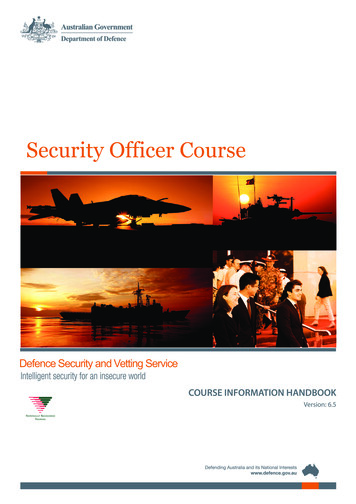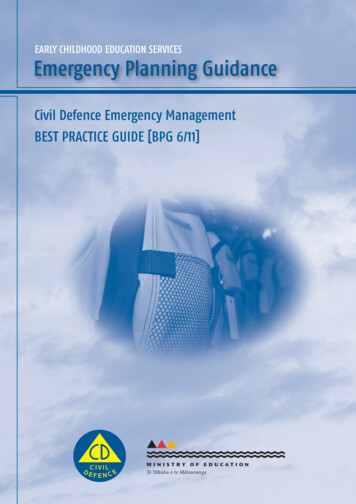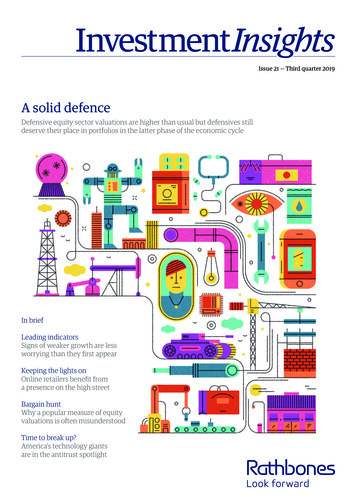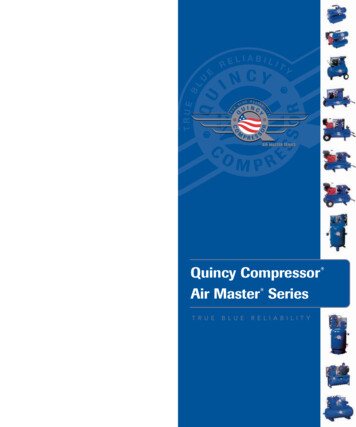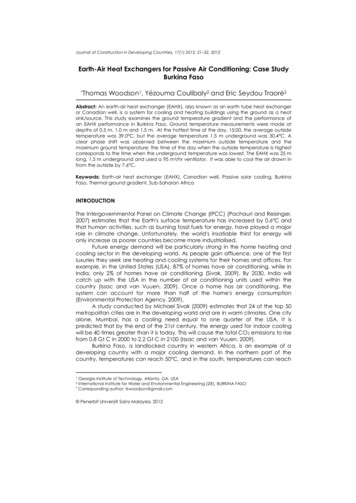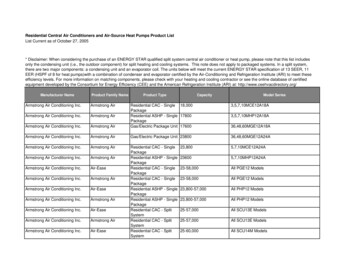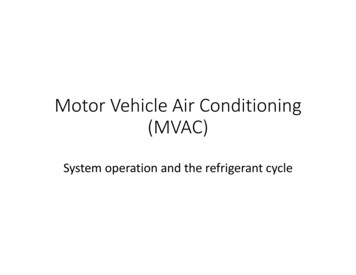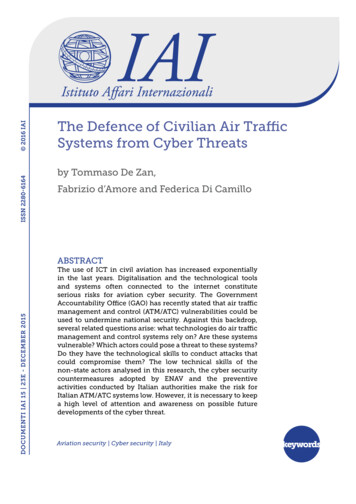
Transcription
2016 IAIISSN 2280-6164The Defence of Civilian Air TrafficSystems from Cyber Threatsby Tommaso De Zan,Fabrizio d’Amore and Federica Di CamilloDOCUMENTI IAI 15 23E - DECEMBER 2015ABSTRACTThe use of ICT in civil aviation has increased exponentiallyin the last years. Digitalisation and the technological toolsand systems often connected to the internet constituteserious risks for aviation cyber security. The GovernmentAccountability Office (GAO) has recently stated that air trafficmanagement and control (ATM/ATC) vulnerabilities could beused to undermine national security. Against this backdrop,several related questions arise: what technologies do air trafficmanagement and control systems rely on? Are these systemsvulnerable? Which actors could pose a threat to these systems?Do they have the technological skills to conduct attacks thatcould compromise them? The low technical skills of thenon-state actors analysed in this research, the cyber securitycountermeasures adopted by ENAV and the preventiveactivities conducted by Italian authorities make the risk forItalian ATM/ATC systems low. However, it is necessary to keepa high level of attention and awareness on possible futuredevelopments of the cyber threat.Aviation security Cyber security Italykeywords
The Defence of Civilian Air Traffic Systems from Cyber Threats 2016 IAIThe Defence of Civilian Air Traffic Systemsfrom Cyber ThreatsISSN 2280-6164by Tommaso De Zan, Fabrizio d’Amore and Federica Di Camillo*DOCUMENTI IAI 15 23E - DECEMBER 2015List of AcronymsIntroduction11.11.21.3Cyber Security and Civil AviationSignificant eventsInternational effortsMain arguments and scope of the study91012142Function and Components of ATM/ATC Systems1533.13.23.3Cyber Threats to ATM/ATC SystemsAttack or not? Two views comparedActors, objectives and modus operandiStatus of the cyber threat to ATM/ATC systems1819212844.14.24.34.3.14.3.2The Italian Case StudyENAV and air traffic management in ItalyCyber threats to ItalyWhat danger to ATM/ATC systems in Italy?Short-term assessmentMedium- to long-term 2p. 366366Tommaso De Zan is Junior Researcher in the Security and Defence programme at the IstitutoAffari Internazionali (IAI). Fabrizio d’Amore is Associate Professor in the Department of Computer,Control, and Management Engineering (DIAG) “Antonio Ruberti” at the Sapienza University ofRome and member of the Research Center of Cyber Intelligence and Information Security (CIS).Federica Di Camillo is Senior Fellow in the IAI Security and Defence programme.Final report of the research project “The defence of civilian air traffic systems from cyber threats”,conducted by the Istituto Affari Internazionali (IAI) with the support of Vitrociset. This report wastranslated from Italian to English with the support of ENAV.
The Defence of Civilian Air Traffic Systems from Cyber ThreatsList of AcronymsDOCUMENTI IAI 15 23E - DECEMBER 2015ISSN 2280-6164 2016 COCWPDDoSDIS3Area Control CenterAircraft Communications Addressing and Reporting SystemAirports Council InternationalAutomatic Dependent Surveillance-BroadcastAeronautical Fixed Telecommunication NetworkALerting ServiceATS Message Handling ServiceAir Navigation Service ProviderAeronautical Operational Information SystemAir Traffic Services Reporting OfficeAtm Surveillance Tracker and ServerAir Space ManagementAdvanced Surface Movement Guidance and Control SystemAir Traffic ControlAir Traffic Flow ManagementAutomatic Terminal Information ServiceAir Traffic ManagementAsynchronous Transfer ModeAeronautical Telecommunication NetworkAir Traffic ServicesAviation SecurityBring-Your-Own-DeviceCivil Air Navigation Services OrganisationCentral CommandComputer Emergency Response TeamCentral Intelligence AgencyCommon ICAO Data Interchange NetworkCentre for Internet SecurityCyber Intelligence and Information Security CenterNational Anti-crime Computer Centre for the Protection of CriticalInfrastructures (Centro nazionale anticrimine informatico per laprotezione delle infrastrutture critiche)National Center of Aeronautical Meteorology and Climatology(Centro nazionale di meteorologia e climatologia aeronautica)Communications, Navigation, SurveillanceParliamentary Committee for the Security of the Republic (Comitatoparlamentare per la sicurezza della Repubblica)Controller Pilot Data-Link CommunicationCentre for the Protection of National InfrastructureCentral Route Charges OfficeControl Working PositionDistributed denial of serviceSecurity Intelligence Department (Dipartimento delle Informazioniper la sicurezza)
The Defence of Civilian Air Traffic Systems from Cyber Threats 2016 IAIDoSEASAEATMPEGNOSENACENAVISSN CICCAIADOCUMENTI IAI 15 23E - DECEMBER enial of ServiceEuropean Aviation Safety AgencyEuropean Air Traffic Management ProgrammeEuropean Geostationary Navigation Overlay ServiceItalian Civil Aviation Authority (Ente nazionale per l’aviazione civile)Italian Air Navigation Service Provider (Ente nazionale perl’assistenza al volo)Eurocontrol Safety Regulatory RequirementsEuropean Satellite Services ProviderFederal Aviation AdministrationFederal Bureau of InvestigationFlight Data ProcessingFlight Plan Data ManagementFlight Information RegionFlight Information ServiceGovernment Accountability OfficeInternational Air Transport AssociationInternational Civil Aviation OrganisationInternational Communications CentreInternational Coordinating Council of Aerospace IndustriesAssociationsIndustrial Control SystemsIndustrial Control Systems Cyber Emergency Response TeamInformation Communication TechnologyIntrusion Detection SystemImprovised Explosive DeviceInternet Engineering Task ForceInternational Federation of Air Line Pilots’ AssociationsInstrument Flight RulesInternet ProtocolInterconnessione reti esterneIslamic State Hacking DivisionIslamic State of Iraq and SyriaInformation Security Management SystemInternational Organisation for StandardisationInformation TechnologyInternational Telecommunication UnionLocal Area NetworkAviation meteorologyMulti Protocol Label SwitchingNonclassified Internet Protocol Router NetworkNetwork Manager Operations CentreNotices To Air MenNational Security AgencyOn-Line Data InterchangeOpen Systems Interconnection
The Defence of Civilian Air Traffic Systems from Cyber ThreatsDOCUMENTI IAI 15 23E - DECEMBER 2015ISSN 2280-6164 2016 TIPUHFUIRVFRVHFVORVPNWANXSS5Open Source Security Testing MethodologyOpen Web Application Security ProjectPan European Network ServicesPoint of PresenceRequest for CommentsRunwaySatellite Distribution SystemStandards and Recommended PracticesSupervisory Control and Data AcquisitionSingle European SkySingle European Sky ATM ResearchSecurity Information and Event ManagementSecret Internet Protocol Router NetworkSecurity Operation CentreSame Origin PolicyStructured Query LanguageSQL-InjectionSafety Regulation CommissionSpecial Visual Flight RulesSystem-Wide Information ManagementTransmission Control ProtocolTransport Layer SecurityTerminal Control AreaThe Onion RouterTrans Pacific PartnershipTransatlantic Trade and Investment PartnershipUltra High FrequencyUpper Information RegionVisual Flight RulesVery High FrequencyVhf Omnidirectional Radio RangeVirtual Private NetworkWide Area NetworkCross-Site Scripting
The Defence of Civilian Air Traffic Systems from Cyber ThreatsIntroductionISSN 2280-6164 2016 IAIThe US Government Accountability Office (GAO), which reports to the Congress,published a report in January 20151 in which it underscored several vulnerabilitiesfound in the Federal Aviation Administration (FAA) air traffic control system.2According to the GAO, these weaknesses threaten “the agency’s ability to ensurethe safe and uninterrupted operation of the national airspace system (NAS).” Thereport concludes with the assertion that, despite the FAA’s attempts to addressthese weaknesses, it has not yet found a solution to some that could expose theirICT systems to cyber attacks.3 In a 2010 report “On the possible national securityimplications and threats deriving from the use of cyber space,” COPASIR4 citeda series of examples – a good portion of which were taken from the Americanexperience – of possible attacks on air traffic management and control (ATM/ATC)5 systems owing to the increasingly pervasive use of information technology.In particular, COPASIR urged legislators and national security bodies to lendthe requisite attention to defending air traffic control systems, considered as acritical infrastructure whose defence helps guaranteeing values ensured by theConstitution, such as the life and safety of persons in-flight and on the groundand the freedom of circulation.6 Along the same lines, in a statement announcingmajor government investments in cyber security, Chancellor of the Exchequer ofthe United Kingdom George Osborne underscored the highly sensitive nature ofair traffic control systems.7DOCUMENTI IAI 15 23E - DECEMBER 2015The COPASIR and GAO reports pinpoint a central national security problem:how the growing dependence of air traffic management and control systems ondigital technologies inevitably introduces new forms of vulnerability. Againstthis backdrop, several related questions arise: What technologies do air trafficmanagement and control systems rely on? Are these systems vulnerable? Whichactors could pose a threat to these systems? Do they have the technological skills toconduct attacks that could compromise them?1US Government Accountability Office (GAO), FAA Needs to Address Weaknesses in Air TrafficControl Systems, January 2015, http://www.gao.gov/assets/670/668169.pdf.2The FAA is the agency of US Department of Transportation that regulates civil aviation in theUnited States.3Aaron Cooper, “Report: Air traffic control system vulnerable to cyber-attack”, in CNN Politics, 2March 2015, http://cnn.it/1FOFlBU.4Italy’s Parliamentary Committee for the Security of the Republic.5Air Traffic Management (ATM) and Air Traffic Control (ATC).6COPASIR, Relazione sulle possibili implicazioni e minacce per la sicurezza nazionale derivantidall’utilizzo dello spazio cibernetico, 7 July 2010, 9825.htm. COPASIR considerations refer mainly to the consequences in case a threatwas to materialise. The report does not express a judgement on the status of ATM/ATC security inItaly.7George Osborne, Chancellor’s speech to GCHQ on cyber security, 17 November 2015, -speech-to-gchq-on-cyber-security.6
The Defence of Civilian Air Traffic Systems from Cyber ThreatsISSN 2280-6164 2016 IAIThis study is part of a broader discussion on the relationship between criticalinfrastructures and cyber security. Indeed, the majority of developed nationsconsider air transportation a critical infrastructure. Singapore has recognised civilaviation as crucial to the “Critical Infocomm Infrastructure Protection” programmeof its national cyber security plan for 2018.8 The United States lists transportationsystems among 18 examples of critical infrastructure in Presidential Directive 7on domestic security, within the context of the National Infrastructure ProtectionPlan.9 The European Commission included transportation as a critical sector in its2006 Directive on European Critical Infrastructures. Finally, with a 2008 decreeentitled “Identification of Critical ICT Infrastructures of National Interest,” theItalian Ministry of Interior included among as critical infrastructure, “Ministries –and the agencies and bodies charged with their oversight – operating in the sectorsof international relations, security, justice, defence, finance, communications,transportation, energy, environment and health.”10Given the importance to national security and their inter-independence, criticalinfrastructures require a high level of protection that is not always easy to ensure.The report entitled “2013 Italian Cyber Security Report: Critical Infrastructureand Other Sensitive Sectors Readiness” drafted by the Cyber Intelligence andInformation Security Centre (CIS) of the Sapienza University of Rome, states thatItaly lags behind other developed countries in implementing a cyber strategy thatgives due consideration to the defence of those infrastructures. The report pointsout that, in the four sectors analysed (public administration, public utilities, majorindustry and the financial sector), there were computerised components that, ifsuccessfully attacked, could lead to serious consequences at national and Europeanlevels. The operators within these macro sectors seemed unaware of being potentialsensitive targets.11DOCUMENTI IAI 15 23E - DECEMBER 2015The dangers to these systems are not only potential, but real and on the rise. In2014 the National Anti-crime Computer Centre for the Protection of CriticalInfrastructures (CNAIPIC) reported 1,151 cyber attacks – 161 of which involved web8Singapore Ministry of Transport, Singapore hosts civil aviation cyber security conference. Pressrelease, 9 July 2015, http://www.news.gov.sg/public/sgpc/en/media ml.9Kasthurirangan Gopalakrishnan et al., “Cyber Security for Airports”, in International Journalfor Traffic and Transport Engineering, Vol. 3, No. 4 (December 2013), p. 365-376, lian Ministry of Interior, Decree of 9 January 2008, Individuazione delle infrastrutturecritiche informatiche di interesse nazionale, G.U. No. 101 of 30 April 2008, 1Cyber Intelligence and Information Security Centre (CIS), 2013 Italian Cyber Security Report.Critical Infrastructure and Other Sensitive Sectors Readiness, Rome, Università “La Sapienza”,December 2013, egati/2013CIS-Report.pdf.7
The Defence of Civilian Air Traffic Systems from Cyber Threats 2016 IAIdefacement12 and 50 Distributed Denial of Service (DDoS)13 – against institutionalinternet websites and critical Italian infrastructures. Of these attacks, 64 weresystem intrusions and 187 compromises due to malware,14 which had infected thewebsites of institutional entities and private enterprises. During the same period,154 potential weaknesses and 148 other possible attacks were revealed.15DOCUMENTI IAI 15 23E - DECEMBER 2015ISSN 2280-6164Figure 1 Attacks addressed by CNAIPIC in 2014Source: 2015 Clusit Report, p. 84.The purpose of this study is to assess eventual weaknesses in Italian ATM/ATC systems that could be exploited by malicious actors. Also observed are theorganisational, technological and process-related counter measures put in place12“An attack carried out against a website and consisting in modifying the contents of thehomepage or of other pages of the website.” See Italian Presidency of the Council of Ministers,National Strategic Framework for Cyberspace Security, December 2013, p. 43, ramework-for-cyberspace-security.pdf.13“An attack that prevents or impairs the authorized use of information system resources orservices.” See “denial of service” in the Cyber Glossary of the National Initiative for CybersecurityCareers and Studies (NICCS): https://niccs.us-cert.gov/glossary#denial of service. Otherinstruments used by Anonymous include malware and phishing.14“A technique to breach the security of a network or information system in violation of securitypolicy.” See “exploit” in NICCS Cyber Glossary: an Association for ICT Security, Rapporto Clusit 2015 sulla sicurezza Ict in Italia, Milan,Astrea, 2015, https://www.clusit.it/download/Rapporto Clusit%202013.pdf.8
The Defence of Civilian Air Traffic Systems from Cyber ThreatsISSN 2280-6164 2016 IAIby the national Air Navigation Service Provider, ENAV,16 as well as by governmentagencies, in compliance with the national cyber strategy and in light of Italy’scommitments within the framework of international legal conventions. To thatend, the first section introduces the theme of cyber security in civil aviation. Abrief analysis of ICT-related incidents that have affected the sector will be followedby identification of the main problems and an outline of the scope of the presentstudy. The second section explains what an ATM/ATC system is and how it works.The third describes the actors that civil aviation authorities consider a threat,including an assessment of the technical skills and objectives of the two mainterrorist organisations, ISIS and Al-Qaeda, hacktivists and cyber criminals. Thefourth section examines the role of and technologies employed by ENAV, witha discussion of possible cyber threats directed against Italy. Conclusions offersome food for thought on the study’s results and on possible developments in therelationship between civil aviation and cyber security.1. Cyber Security and Civil Aviation“Aviation relies on computer systems extensively in ground and flight operationsand air traffic management, and we know we are a target.”17Tony Tyler, Director General of the International Air Transport AssociationDOCUMENTI IAI 15 23E - DECEMBER 2015As it has in many other complex human activities, the use of ICT in civil aviation hasincreased exponentially over recent years, from the development and constructionof aircraft to communications and navigation instruments, along with all thethousands of connections that link the various parts of an airport. As in otherfields, the digitalisation and placement online of such complex instrumentationhave introduced considerable problems associated with cyber security. It isnot surprising then that a 2012 report by the British Centre for the Protection ofNational Infrastructure (CPNI)18 found that the interface and interdependenceinherent to ICT-use has raised the vulnerability of aircraft and aviation systems,and consequently the impact of eventual compromise.19 Despite financial andmanagerial improvements, it remains clear that weaknesses linked with cyberactivity pose a noteworthy threat to civil aviation.16National Flight Assistance Agency.Jonathan Gould and Victoria Bryan, “Cyber attacks, drones increase threats to plane safety:insurer”, in Reuters, 4 December 2014, http://reut.rs/1tRTAOZ.18British government authority that offers advice and recommendations on the security anddefence of national infrastructure industries and organisations.19Centre for the Protection of National Infrastructure (CPNI), Cyber Security in Civil Aviation,August 2012, n-civil-aviation.179
The Defence of Civilian Air Traffic Systems from Cyber ThreatsISSN 2280-6164 2016 IAIFigure 2 ICT technologies in civil aviationSource: American Institute of Aeronautics and Astronautics, A Framework for AviationCybersecurity, August 2013, p. 8, I IAI 15 23E - DECEMBER 2015The goal of this section is to provide an introductory framework for the relationshipbetween cyber security and civil aviation, with the initial presentation of some ICTincidents that have affected the sector. It will go on to examine international effortsto combat cyber threats and the counter measures currently in place. Finally, themain ICT problems that condition in-flight and ground security will be described.101.1 Significant eventsCivil aviation has historically been an especially appetising ta
ACI Airports Council International . ARO Air Traffic Services Reporting Office ARTAS Atm Surveillance Tracker and Server ASM Air Space Management ASMGCS Advanced Surface Movement Guidance and Control System ATC Air Traffic Control ATFM Air Traffic Flow Management . IETF Internet Engineering Task
